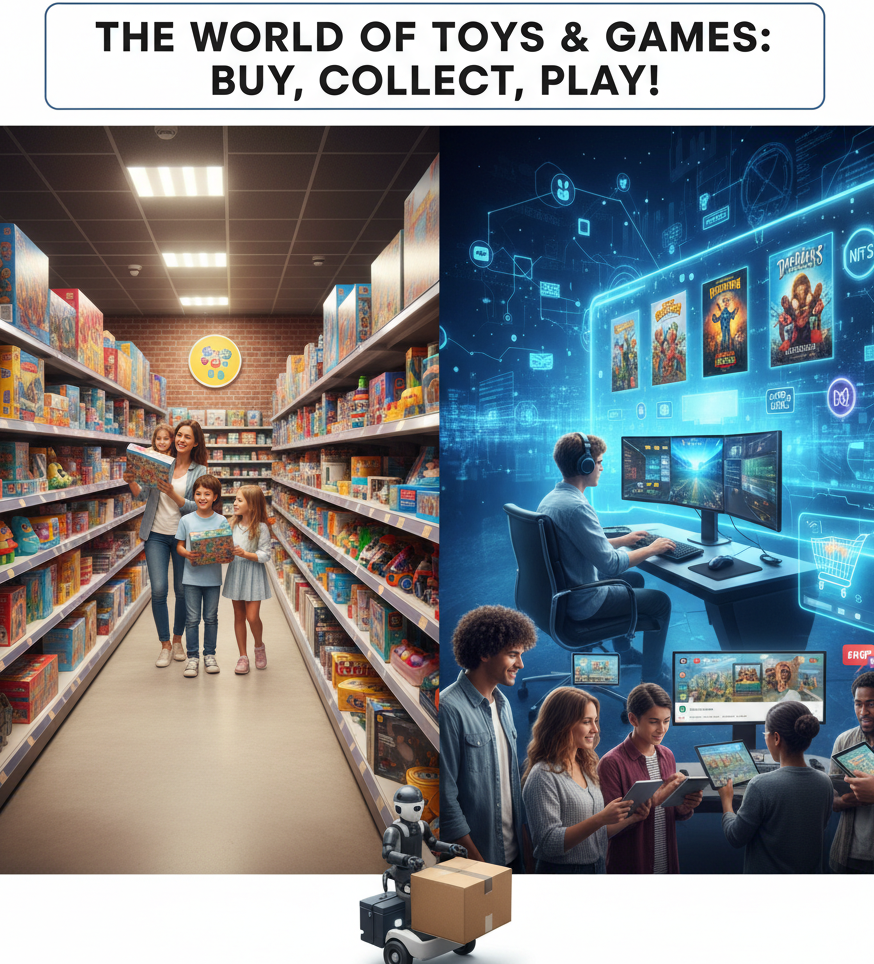The global toys and games market is a colossal industry, constantly evolving and expanding. From classic board games to cutting-edge video game consoles, and from collectible action figures to educational STEM kits, the variety is immense. This sector isn’t just about play; it’s a significant economic force, driven by innovation, nostalgia, and ever-changing consumer trends. Understanding the dynamics of sales and transactions within this vibrant market is crucial for both businesses and consumers.
A Market Overview: Who’s Playing and How?
The toys and games market caters to an incredibly broad demographic. While children remain a core audience, adults constitute a rapidly growing segment, fueling demand for hobby-grade collectibles, sophisticated board games, retro gaming systems, and high-end video game peripherals. This “kidult” trend has profoundly impacted market strategies, pushing manufacturers and retailers to diversify their offerings and marketing approaches.
Sales channels are equally diverse. Traditional brick-and-mortar toy stores still hold sentimental value and provide an experiential shopping journey. However, the rise of e-commerce has revolutionized how toys and games are bought and sold. Online marketplaces, direct-to-consumer (DTC) websites, and social media platforms now account for a significant portion of transactions, offering unparalleled convenience, selection, and competitive pricing.
Key Drivers of Sales in the Toys & Games Sector
Several factors consistently drive sales and influence purchasing decisions in this dynamic market:
- Innovation and Technology: New technologies constantly inject excitement into the market. Augmented Reality (AR) and Virtual Reality (VR) games, interactive learning toys, and app-connected gadgets capture consumer imagination.
- Entertainment Franchises: Movies, TV shows, comic books, and video game franchises are powerful sales drivers. Tie-in merchandise, from action figures to themed board games, often generates massive hype and demand, especially around major releases.
- Nostalgia and Collectibility: The “kidult” market thrives on nostalgia. Reboots of classic toy lines, retro video game consoles, and collectible items with high resale value attract adult consumers willing to invest in their childhood memories or passion projects.
- Educational Value: Parents increasingly seek toys that offer educational benefits, promoting STEM skills, cognitive development, and creative thinking. This focus has led to a boom in “edutainment” products.
- Social and Experiential Play: Board games, party games, and outdoor play equipment continue to be popular, facilitating social interaction and providing tangible experiences away from screens.
- Sustainability and Ethical Sourcing: Growing consumer awareness about environmental and social issues influences purchasing. Demand for eco-friendly toys, sustainably sourced materials, and ethically produced goods is on the rise.
The E-commerce Revolution: Streamlining Transactions
The digital realm has transformed toy and game transactions, offering both opportunities and challenges:
- Global Reach: Online platforms enable businesses to reach a worldwide customer base, expanding market potential far beyond geographical limitations.
- Convenience: 24/7 accessibility, door-to-door delivery, and easy price comparison are major draws for busy consumers.
- Wider Selection: Online stores typically offer a much broader inventory than physical stores, including niche products and international imports.
- Data-Driven Marketing: E-commerce platforms provide valuable data on consumer behavior, allowing businesses to personalize marketing efforts, recommend products, and optimize sales strategies.
- Challenges: Intense competition, logistical complexities (shipping, returns), cybersecurity concerns, and the need for robust customer service are hurdles businesses must navigate.
Payment Systems: Ensuring Smooth Transactions
Diverse payment options are essential for facilitating sales in today’s market:
- Credit/Debit Cards: Still the most common method for online and in-store purchases, offering convenience and fraud protection.
- Digital Wallets: Services like PayPal, Apple Pay, and Google Pay provide quick, secure, and seamless checkout experiences, especially on mobile devices.
- Buy Now, Pay Later (BNPL) Services: Platforms like Afterpay and Klarna allow consumers to split payments, making larger purchases more accessible and appealing.
- Gift Cards: A popular choice for gifting, driving future purchases and customer loyalty.
- Cryptocurrency (Emerging): While not mainstream, some specialized retailers are beginning to accept cryptocurrencies, catering to a tech-savvy niche.
For businesses, integrating multiple secure payment gateways is critical to minimize cart abandonment and cater to diverse customer preferences.
The Role of User-Generated Content and Social Proof
In the toys and games market, consumer trust and enthusiasm are powerful sales tools.
- Reviews and Ratings: Online reviews are paramount. Positive feedback can significantly boost sales, while negative reviews can quickly deter potential buyers. Businesses actively encourage customers to leave reviews.
- Unboxing Videos and Playthroughs: YouTube and TikTok are filled with videos where enthusiasts unbox new toys, demonstrate gameplay, and offer honest opinions. These videos serve as authentic product showcases and often influence purchasing decisions more than traditional advertising.
- Influencer Marketing: Collaborating with popular toy reviewers, gamers, and family vloggers can generate massive exposure and credibility, especially when targeting specific demographics.
- Community Forums: Online communities dedicated to specific games, toy lines, or hobbies foster engagement and advocacy, where members share experiences, tips, and recommendations.
Navigating Returns and Customer Service
Efficient after-sales service is vital for customer satisfaction and repeat business:
- Clear Return Policies: Transparent and easy-to-understand return policies build consumer confidence.
- Responsive Customer Support: Quick and helpful responses to inquiries, whether about product functionality, shipping, or returns, are crucial. This can be via email, phone, or live chat.
- Troubleshooting Guides: For complex toys or games, readily available online troubleshooting guides or FAQs can empower customers to resolve minor issues themselves.
- Warranty and Guarantees: Offering warranties provides assurance, especially for higher-value items like electronics.
The Future of Toys & Games Sales
The market shows no signs of slowing down. We can expect continued integration of technology, with AI and personalized experiences becoming more prevalent. The lines between physical and digital play will blur further, offering hybrid experiences. Sustainability will move from a niche concern to a core expectation. Collectibles, driven by both nostalgia and new franchises, will likely continue to thrive, bolstered by digital authentication and potentially even NFTs for unique items.
Conclusion
The world of toys and games sales and transactions is a dynamic and exciting landscape. Success hinges on understanding consumer desires, embracing technological advancements, optimizing diverse sales channels, and providing exceptional customer experiences. Whether you’re a seasoned retailer, an indie game developer, or a passionate collector, navigating this market effectively means staying attuned to its ever-changing rhythms and prioritizing the joy and engagement that these products bring.







